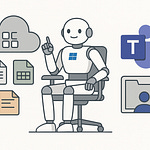Do you really need your own Copilot Studio Agent—or is that just the AI hype talking? This is the decision almost every business runs into right now. Start too fast with the wrong Copilot, and you waste months. Start too slow, and you fall behind competitors already automating smarter. In this session, I’ll walk you through exactly how we tested that question inside a real project, and the surprising twist we found when we compared a quick generic solution with a dedicated Copilot Studio build.
The False Promise of a Quick Fix
What if the fastest way to add AI is also the fastest way to get stuck? That’s the trap many organizations fall into when they reach for the first Copilot that’s marketed to them. On paper, it feels efficient. There’s a polished demo, a clear pitch, and the promise that you can drop AI into your workflows without having to think too hard about design. But speed isn’t always the advantage it looks like. The problem is that these quick implementations rarely uncover the deeper needs of the business, so what starts as a promising shortcut often ends as a dead end.
Think about how most teams start. Someone sees a Copilot for email summarization or for document search, and it looks amazing in isolation. Decision makers don’t always stop to ask whether it fits the daily work of their employees, or whether it connects to the systems holding their critical data. Instead of mapping real tasks, they grab what’s already packaged. In the following weeks, the AI gets some attention, maybe even excitement, but then adoption stalls. People realize it’s not actually helping with the issues that drain hours every week.
You can see this clearly with sales teams. Imagine a group that spends most of its time chasing leads, preparing quotes, and responding to client questions. If leadership gives them a generic Copilot designed to rephrase emails or summarize meeting notes, it can spark some “wow moments” in a demo. But when the team starts asking it for pricing exceptions, or whether a client falls under a certain compliance requirement, the Copilot suddenly looks shallow. It hasn’t been connected to pricing tables, CRM data, or specific sales playbooks. Without that grounding, answers may sound smooth but remain useless in practice.
This is where the natural limits of generic AI tools show up. Without domain-specific knowledge, they work like bright generalists: competent at surface-level communication but unable to provide depth when it matters. Users ask detailed questions, and the Copilot either guesses wrong or defaults to vague, unhelpful phrases. That’s when confidence erodes. Once employees stop trusting what the agent says, they quickly stop using it altogether. At that point, the entire rollout risks being labeled as another “AI toy” rather than a serious capability.
The data on AI adoption backs this up. Studies tracking enterprise rollouts have shown that projects without personalization and role-specific tailoring have far lower usage six months after launch. It’s not because the technology itself suddenly stops working, but because the absence of context makes it irrelevant. Companies often confuse demonstration quality with real deployment value. A good demo is built around small, curated examples. Daily operations, in contrast, bring messier inputs and require structured background knowledge. When the Copilot can’t adapt, the mismatch becomes obvious.
So why do businesses keep making this mistake? Part of it is hype. AI is marketed as a plug-and-play capability, something you can switch on the same way you activate a new license in Microsoft 365. Leaders under pressure to “show progress in AI” often prioritize quick visibility over sustainable impact. They deploy something fast, point to it in presentations, and check the box. But hype-driven speed does not equal measurable results. The employees who actually have to use the tool feel that gap instantly, even if dashboards report “successful deployment.”
This difference between speed and progress creates the real fork in the road: faster doesn’t always mean further. Yes, you can have an agent functioning tomorrow if the bar is just appearing inside Teams or Outlook. But whether that agent becomes indispensable depends entirely on whether it was tailored to actual roles and workflows. Efficiency doesn’t come from hitting “enabled.” It comes from asking the harder question right at the beginning: do we need a Copilot Studio agent that reflects our processes, our language, and our data?
That’s the pivot point where projects either stall or scale. Teams that stop to ask it can design agents that employees genuinely want to use, because they recognize immediate relevance. Teams that skip it keep adding tools that look familiar but fail to deliver. The irony is that the slower, more deliberate start often ends up being the faster route to adoption because it prevents wasted cycles on solutions that don’t fit.
The next step is figuring out how to ask that harder question in a structured way. And the starting point for that is not technology at all, but people. We need to decide: who exactly is this agent for?
Personas: Who Is the Agent Really For?
It’s easy to fall into the trap of designing something “for everyone.” It feels inclusive, maybe even efficient, but what it usually produces is so watered down that nobody gets real value out of it. In AI projects, that catch-all mindset almost guarantees disappointment. The first real question you need to answer is this: who exactly is the agent meant to help? Without knowing that, you’re not building a Copilot—you’re just building a bot that can hold small talk.
Defining personas isn’t a fluffy exercise. It’s the foundation that makes the rest of the project possible. When you hear “persona,” it’s not about marketing profiles or fictional characters with hobbies and favorite drinks. In this context, a persona is about identifying the role, responsibilities, and environment of the person your agent serves. It shapes what the agent needs to know, how it answers questions, and even the tone it should use. A “generic employee” doesn’t help your AI figure out whether it needs to be pulling real-time compliance data or giving step-by-step fix instructions. That vagueness is why so many early projects ended up with agents that could say “hello” in five different ways but couldn’t resolve the actual problem users came for.
Here’s the difference it makes in practice. If you picture “the employee” as your persona, you might decide the agent should help with HR policies, IT support, and document queries all in one. The agent then has to spread itself thin across multiple domains while not excelling at any of them. Compare that with defining a persona like “a field engineer who needs compliance answers instantly at customer sites.” Immediately, the design changes. You know this person is often mobile, has limited time, and needs crisp, authoritative guidance. That persona leads you to connect the Copilot to compliance databases, phrase answers in unambiguous ways, and prioritize speed of delivery over long-winded explanations. You can see how one is vague and unfocused, while the other is precise enough to guide the actual build.
The real-world difference becomes even clearer when you look at contrasting roles. Take an IT helpdesk agent persona. This group needs quick troubleshooting steps, system outage updates, and the ability to escalate service tickets. The language is technical, the data likely comes from tools like ServiceNow or Intune, and the users expect accurate instructions they can follow under pressure. Now compare that to a finance analyst persona. This user is more concerned with accessing financial models, understanding compliance around expense approvals, or generating reports. They work with numbers, approval chains, and financial terminology, and they need to trust that the Copilot won’t expose sensitive data to the wrong audience. Design for “the employee,” and you miss both completely. Design for each specific persona, and the agent becomes not just useful but trustworthy.
Another overlooked benefit of defining personas is alignment inside the organization. When you put a clear persona on the table, teams from HR, IT, compliance, or operations can quickly agree on what the scope actually is. Instead of endless debates about what the Copilot “could do,” everyone now has a reference point for what it *should do*. It turns into a compass for decision-making. If you’re debating whether to add a feature, you can check against the persona: does this help the field engineer get compliance answers faster? If yes, great. If no, then it probably doesn’t belong in the first version. That kind of discipline keeps the project from ballooning into an unfocused wishlist.
Personas also go beyond guiding scope. They drive knowledge requirements. For every persona, you have to ask: What information do they need on a daily basis? Where does that information currently live? How fast does it change? That analysis determines how you integrate knowledge sources into the Copilot and how you keep it updated. If you ignore personas, you’ll either overload the agent with irrelevant data or, worse, starve it of the content it actually needs. Either way, trust from end users erodes—and once trust is gone, adoption doesn’t recover easily.
A well-defined persona is not about limiting possibility. It’s about direction. Without it, AI projects wander, chasing every cool feature until they collapse under their own ambition. With it, you have a steady guide. The persona becomes the compass, keeping the project on course, making sure that the Copilot is being built for real people with real tasks, not for some abstract idea of “the employee.” And that is the difference between an agent that gets ignored after launch versus one that people actively rely on.
With personas in place, the picture finally becomes sharper. You know who you’re building for. The next natural question is: what exactly should we help them do?
Use Cases that Actually Matter
Not every task deserves a Copilot, even if it technically can have one. This is where many organizations get carried away. Once the brainstorming starts, it feels like every small frustration could become an AI feature. Someone proposes, “What if it could remind us to submit our timesheets?” Another adds, “Maybe it could draft thank-you notes after customer meetings.” Before long, the list is so long that nobody remembers what problem they were actually trying to solve. The danger isn’t having too many ideas—it’s trying to make one agent responsible for all of them. At that point, the Copilot stops feeling like a specialist and becomes more like an overwhelmed intern.
The reality is that brainstorming sessions almost always generate dozens of possible directions. Finance asks for reporting help. HR imagines onboarding flows. Sales wants automated pitch decks. IT dreams of faster ticket triage. On their own, none of these are bad. But the question isn’t “can AI do this,” it’s “does it matter if AI does this?” That small shift exposes how many ideas sound clever but offer almost no return once implemented. Just because you *can* automate minor questions doesn’t mean it’s worth the effort of building, training, and maintaining that automation.
If you’ve ever looked at the outcome of over-scoped projects, the pattern is predictable. The agent ends up loaded with dozens of disconnected tasks, doing each one at a mediocre level. Take something simple like answering whether a meeting room has a projector. Sure, a Copilot can handle this kind of FAQ with ease. But the impact is minimal. Compare that to an agent that validates if a sales proposal meets strict regulatory criteria before it ever gets sent. One saves a bit of annoyance. The other prevents legal risks and accelerates revenue. The contrast shows why prioritization matters.
A useful way to cut through the noise is to apply three criteria at the start: value, frequency, and feasibility. Value means asking how much the task really helps the business when automated. Frequency looks at how often it occurs—solving a small pain point that happens 50 times every day may outweigh a bigger challenge that only happens once a quarter. Feasibility keeps the first two honest—if the required data doesn’t exist in digital form or can’t be securely accessed, then it’s not a good candidate for phase one. When teams score every use case through that lens, the overloaded wishlists suddenly shrink into a focused plan.
There’s also evidence that smaller pilots with narrow scopes perform better. Organizations that commit to just two or three use cases at the beginning tend to grow adoption internally at a faster pace. It plays out like this: the Copilot launches with clear value in one or two areas, employees gain confidence, and momentum builds. Compare that to agents that tried to cover ten different scenarios at once. Those projects often collapsed under the weight of inconsistent quality and frustrated feedback. It turns out that a narrower start creates a stronger foundation to expand later.
Consider two fictional teams as an example. The first decided to design a Copilot that supported HR, IT, finance, and customer service all in one. They spent months mapping data sources, building convoluted workflows, and promising that it would be a one-stop solution for the entire organization. When launch day came, early users discovered it couldn’t handle any of the departments’ needs properly. Most dropped it within weeks. The second team, by contrast, focused only on helping field engineers confirm compliance rules before installations. They launched in a fraction of the time, adoption was immediate, and the engineers started asking for new scenarios based on their positive experience. Same technology, very different results.
So the struggle isn’t to find enough use cases—it’s to resist trying to cover all of them at once. The question that matters is: which scenarios are worth betting on? Which ones, if automated, would turn into an everyday tool people actually trust? That’s how you separate the noise from the signal. Those chosen use cases tend to be the ones where employees feel a visible improvement in how they work, not just how many steps are automated. They make tasks less frustrating and more reliable.
The takeaway here is that the best use cases don’t just automate work; they actually change how work feels to the end user. When someone can finally say, “this Copilot just made my job less stressful,” you’ve found the right fit. Now that we know who we’re designing for and what they really need, the next step is figuring out which skills and knowledge we have to teach the agent so it can actually deliver.
Teaching the Agent Skills and Knowledge
An agent isn’t smart until you teach it what your team already knows. That’s the part many projects underestimate. Installing a Copilot out of the box may get you something that looks functional, but if it hasn’t been trained with the same knowledge your employees rely on, it won’t get far. At best, it fills in surface-level gaps with polished but vague answers. At worst, it gives users unreliable guidance and undercuts trust completely. What makes the difference is knowledge grounding—feeding the agent with the right data and connecting it to the workflows where real work actually happens.
Think about the contrast. A Copilot with no context can tell you how to write a professional email because it’s seen millions of examples. But if someone asks about the specific terms of your company’s refund policy or what counts as capital expenditure in your finance system, the same Copilot suddenly looks empty. It may string together something that sounds reasonable, but being “reasonable” isn’t enough when the wrong wording creates delays, compliance issues, or lost revenue. Now picture an agent that has been connected directly to your company’s approved knowledge bases, documented processes, and up-to-date systems. It doesn’t just respond with generics. It can pull precise rules from your contracts folder, cite the right section of your compliance handbook, or route the request through an internal workflow. That’s when a Copilot moves from being a novelty to being a trustworthy colleague.
In Copilot Studio, there are two major ways of tuning this intelligence—knowledge grounding and skills. Knowledge grounding is the part where you connect the Copilot to the sources your organization already depends on. This could be SharePoint libraries where policies live or internal wikis that staff consult every day. By bringing these into the agent’s environment, you give it the ability to retrieve and reuse content that matches your exact requirements rather than relying on vague language models guessing their way through.
Skills are what make the Copilot active instead of just informative. They’re the connectors to APIs, workflows, and applications that let the agent take action rather than simply talk. For example, linking to ServiceNow ticketing allows an IT support persona to raise, update, or close tickets directly. Instead of rewriting policy excerpts, the Copilot can guide the user through the steps while actually completing the task in the background. This combination of knowledge grounding and integrated skills separates a chatbot from a real assistant. A chatbot recites; an agent acts.
The risks of skipping this step show up quickly. If a Copilot gives even a single high‑stakes answer that turns out wrong, users remember. That memory lingers far longer than any good experience, especially in tightly regulated industries. It takes only one mistaken assurance about compliance or one inaccurate financial statement to damage the trust an entire team has in the tool. Rebuilding adoption after that kind of setback is far harder than investing in proper data integration up front.
Even when the groundwork is solid, the challenge isn’t over. Business rules change, workflows evolve, and policies update. That means training an agent isn’t a one‑time task. It’s an iterative process that requires tuning over time. A new compliance framework may require re‑grounding. A system migration might mean updating skills. Even changes in language—like how teams talk about products or processes—can throw off performance if ignored. This continuous refinement loop is what separates teams who see growing value from those whose Copilot fades into irrelevance after launch.
The reward for sticking with it is that your Copilot starts to work in real time with the same depth your experts bring to their roles. An HR Copilot can provide policy details without needing to loop in HR staff for every small question. A finance Copilot can walk an analyst through approval chains while pulling the right numbers from current systems. These aren’t just efficiency wins; they change how people feel about using the tool. Instead of being one more system to wrestle with, it becomes the fastest path to reliable answers and completed tasks.
This is why the line between a chatbot and a Copilot matters. A chatbot holds conversations; a Copilot takes context, combines it with actions, and turns it into support that people trust. The strongest agents are the ones that mirror what your team already knows and can act on that knowledge immediately. And once the design and training are in place, the final challenge becomes how you manage the rollout itself—because a technically solid Copilot can still fail if it never makes it through adoption.
Avoiding Pitfalls on the Road to Go-Live
The most common way Copilot projects fail isn’t in development—it’s in rollout. Teams often spend weeks fine-tuning personas, building use cases, and wiring in data sources, only to watch the whole initiative stall once it’s time to actually hand the agent to employees. That’s not because the tech doesn’t work, but because the human side of the rollout often gets neglected. Governance isn’t defined, expectations aren’t managed, or adoption plans are an afterthought. What starts with energy at the kick-off often fizzles before real results appear.
If you’ve ever seen the excitement of a project launch meeting, you know the feeling. A roadmap is on the wall, milestones are agreed, and everyone is eager for the first demo. The first workflow gets implemented, the Copilot answers test queries, and everything looks promising. But between that demo and a true go-live, the ground shifts. Leaders ask for extra features mid-project, end users aren’t sure how or when to use the new tool, and project teams realize they never nailed down procedures for who reviews changes or approves training data. The gap between the build and the rollout is where momentum quietly dies.
Think about an agent that worked perfectly during internal testing but stumbled on release. Employees opened it once or twice, didn’t understand what problems it solved, and walked away unimpressed. In some cases, the builder team focused so much on technical accuracy that they never prepared the communication plan. End users assumed the Copilot could answer everything about their role. Instead, when they asked the first unsupported question, the agent responded vaguely. That one moment was enough to erode trust. Adoption never recovered because the rollout wasn’t designed to handle user perception and feedback.
Scope creep adds another layer of trouble. Let’s say a project originally targeted two high-value scenarios for finance analysts. Halfway through, requests start pouring in: can it also help HR onboard new employees, or maybe offer IT troubleshooting steps? Leadership wants to show impact across departments, so those requests get added. Now the project team is stretched thin, deadlines slip, and the initial high-value use cases end up delayed. By the time testing wraps, the Copilot tries to serve five directions at once and satisfies none of them. Rollout gets pushed back again, trust in the project wears thin, and the original promise never materializes.
Avoiding that spiral requires structure. One proven method is phased rollouts. Instead of forcing the agent on the entire company at once, start with a small pilot group that represents the core persona. Collect their feedback, monitor the types of questions they ask, and measure adoption rates in a controlled environment. If issues appear, adjustments can be made quietly before scaling up. Alongside this, setting transparent measures of success helps keep enthusiasm grounded. If success is defined as “50 percent of tickets resolved without human help” or “compliance checks completed in under two minutes,” then everyone can see progress in clear terms instead of vague claims.
Good AI projects also have champions—individuals who serve as internal translators between the tech team and the everyday user base. These champions help to set the right expectations, showing colleagues where the Copilot excels and where it doesn’t. Instead of promising that “AI will solve everything,” they explain what specific tasks it supports and why those were chosen as priorities. That kind of advocacy has more weight coming from peers than from IT announcements that pop up in a company newsletter. It builds credibility person by person, which scales adoption in a way no announcement alone achieves.
Momentum after the first demo comes from managing this balance of ambition and reality. The agent shouldn’t be hidden in an innovation lab without visibility, but it also can’t be thrown to the whole workforce untested. Rollouts that succeed usually have patient sequencing—pilot, expand, then embed into daily workflow. The patience prevents failure, the sequencing builds confidence, and the visible wins give leaders something real to point to when reporting back. Projects collapse when they skip one of those elements, either rushing out too wide or staying too limited for too long.
The truth is that agents don’t become superheroes overnight. They grow into their role through steady milestones, structured rollouts, and active guidance from inside the organization. A launch done with clarity and trust gives the Copilot a chance to evolve into an indispensable teammate instead of a novelty. But every step depends on the decision made long before rollout began: choosing wisely at the very first decision point.
Conclusion
The hardest decision in a Copilot project isn’t how to build it—it’s deciding if you actually need one. That first call shapes everything else. Too many teams race ahead because building feels like progress, only to discover the agent never fit a real need.
The future of AI in business won’t be defined by who launches the most flashy agents, but by who puts the right ones into the right hands. Before starting an AI pilot, step back. Ask who it’s really for, what problems it should solve, and whether those cases matter enough to justify building an agent.











